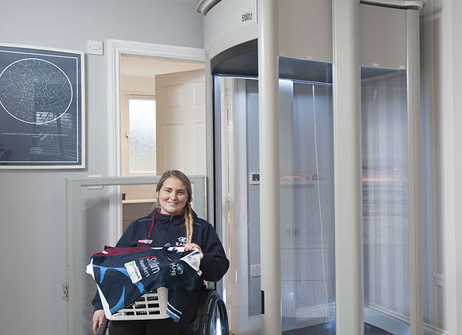Spinal cord injury rehabilitation and the importance of accessible housing
Our latest blog discusses the importance of accessible housing for spinal cord injured adults, the role housing plays during rehabilitation and the impact on your clients physical and mental health and wellbeing.
A spinal injury has the potential to be a very serious physical trauma that can have a significant and permanent impact on many aspects of daily life. Spinal cord trauma can be caused by injury, disease, or infection. Damage to the spinal cord disrupts the communication between the brain and the body and in most cases, results in loss of feeling, movement, or sensation below the damaged area. The higher up the damage to the spinal cord, the more movement and sensation will be lost, often resulting in the use of a wheelchair.
Adapting to a Spinal Cord Injury
Your client may experience a number of feelings and emotions such as shock, distress or disorientation following an accident; loss of motivation, depression and anxiety, concerns around relationships and the future, and the management of pain and spasms are also considerations. In addition to this, the worry and stress of living in an unadapted home can have a significant impact on physical and psychological wellbeing.
Importance of Accessible Housing
The provision of a suitably adapted home plays a crucial role in your client’s rehabilitation. A study carried out by spinal cord injury charity, Aspire, found that correctly adapted housing enables spinal cord injured adults to maintain freedom and independence by providing all the adaptations necessary to take care of themselves, to be able to move freely around the home, to pursue leisure and employment opportunities, and to maintain personal dignity.
In enabling all this, adapted housing is proven to provide individuals with the resources to develop a good quality of life. It also means SCI adults felt that they were not a burden to anyone and, equally, the wife/husband/partner did not feel they had to be responsible for everything in the house, such as looking after children, or carrying out daily chores.
The study found that unadapted housing took away an individual’s dignity and compromised the personal hygiene that was crucial to having a good quality of life. SCI adults became reliant on others notably the family to assist them with daily personal bodily needs, including going to the toilet and washing which could lead to feelings of stress, anxiety, loss of control and low self-esteem. One respondent from the Aspire survey commented
‘I’ve always been a very independent person. But because of the problems with the house, I can’t go anywhere without someone having to help me out and get me into the house again ‘Having the adaptations would mean I wouldn’t have to camp out downstairs, I wouldn’t have to have a commode or a hospital bed downstairs and be embarrassed about that’.
Hospital Discharge
The study also found that due to the lack of available accessible housing in the UK, 86% of people with SCI are likely to be discharged into a home that doesn’t meet their physical needs. On leaving hospital, many SCI adults are forced to return to an unadapted property, often having to live in just one room downstairs. The effect of this meant SCI adults were less likely to be employed or see their friends, have poor health and are more likely to suffer from depression and have suicidal thoughts.
Stiltz Homelifts customer, Dani Watts, 31, suffered a spinal injury in 2018. “After a spinal injury there is obviously a period of adjustment and rehabilitation. But compared to moving back home, being in hospital is the easy part. When you get home and out into the real world, it is so much harder.
This comment from Dani clearly articulates how important the correct home adaptation is ‘You only become disabled when you are in an environment which is not adapted.â€
Impact on NHS
The lack of suitable housing results in more spinal cord injured patients unnecessarily spending additional weeks in hospital waiting for adaptations to their own home, or for a wheelchair-accessible home to be found. It costs the NHS £960 per day for a bed in a Spinal Injury Centre. This avoidable cost is also incurred when individuals are readmitted for spinal cord injury treatment due to bladder infections, pressure sores or falls caused by living in unadapted housing.
In addition to this, one out of five people with SCI live temporarily in a care home for an average of three years. The impact of this cannot be underestimated. It can quickly lead to depression, reduced quality of life, a delay in the rehabilitation process (i.e., re-learning of skills required for daily living activities), and the breakdown of relationships with family and friends.
Rehabilitation
Living in an adapted home can also be a crucial factor when considering rehabilitation. Physical skills learnt during rehabilitation can be transferred to the community setting immediately. This may include practicing and refining new wheelchair techniques around the home, transferring safely to and from a wheelchair, utilising adapted bathroom/wet room independently, managing bowel care, and tending to skin care to avoid pressure ulcers.
Home Adaptations
Relevant home adaptions are essential to ensure a level of independence and to remove barriers to rehabilitation. This may include wheelchair ramps, door widening, adapting a kitchen, installing a wet room, homelifts etc. It is important that SCI adults feel safe and can move freely around the home to carry out daily activities such as personal care, cooking, and supporting children. Movement between floors is essential to improve confidence and wellbeing, with the aim of establishing a normal life as possible. The installation of a homelift can achieve this. The Stiltz Trio+ is one such product and is designed to accommodate a wheelchair user to enable safe and easy access between floors. This particular homelift, can be installed almost anywhere in the home and is a self-supporting structure so doesn’t need load-bearing walls. It runs using a quiet electric motor which is often a consideration when thinking about mechanical equipment which could cause noise nuisance to neighbours.
Wheelchair Transfer
Often, for budgetary considerations, stair lifts are specified for those needing to move between the floors in their home, however this may not be a suitable solution for a wheelchair user. Transferring between wheelchair and stair lift, especially at the top of the stairs without assistance may present a risk. It may also be impractical to have two wheelchairs – one upstairs and one downstairs. The stair lift itself will also encroach on the stairs which may create a trip hazard for other members of the household.
Stuart Barrow, Occupational Therapist commented, “As an Occupational Therapist working with SCI adults, we consider all areas of daily living in order to enable independence, reduce barriers and facilitate rehabilitation. With regards to housing, our role is to work with clients to understand how they wish to live and make recommendations for relevant adaptions to the home. This may include access to the home (i.e., doorway widening, wheelchair ramps), installation of an adapted kitchen, bathroom/wet room, and allowing safe access between floors by installing a home lift. We are goals-focused and client-led in order to help individuals meet their rehabilitation objectives.
Useful Resources
Aspire – is a leading national charity that provides practical support to people who have been affected by Spinal Cord Injury.
Spinal Injuries Association (SIA) provides services to share information and experience and campaign for change, ensuring SCI adults can lead a full and active life.
Back Up – is a national charity that inspires people affected by spinal cord injury to get the most out of life.
Funding – Your client may be entitled to a Disabled Facilities Grant to assist with the cost of home adaptions.

“The study also found that due to the lack of available accessible housing in the UK, 86% of people with SCI are likely to be discharged into a home that doesn’t meet their physical needs…”






